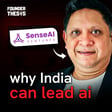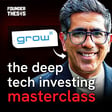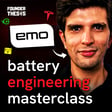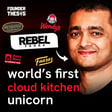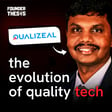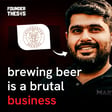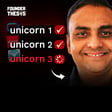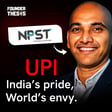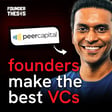Introduction to Sanghibs and India's Export Evolution
00:00:00
Speaker
Hi, I'm Sanghibs, co-founder and CEO of Adverb Technology. India has a long legacy of exporting software to the world. Companies like Infosales, Vipro, TCS, IEL, the giants in this field created on the back of this industry.
00:00:28
Speaker
The most inspiring thing which I see now is that Indian founders are daring to export hardware to the world. And a perfect example of this is Adverb, which is as it is A-D-D-V-E-R-V. Adverb is exploding robotic solutions to the world.
00:00:45
Speaker
They help companies to automate factory or warehouse operations through a whole suit of robots and software. And the most inspiring thing about them is that they are going out and beating large legacy foreign players, Japanese European players and winning deals.
Inspiration and Background of Sanghibs
00:01:01
Speaker
Adverb is one of the best cognates of these in this field and they've raised more than 65 million dollars from the likes of Reliance and others. I hope you are as inspired after listening to Sagip narrate the story of building Adverb as I was. I am Akshay Dutt and this is the promo thesis for us.
00:01:29
Speaker
Let's start with a little bit of your background. You are running a robotic automation company. What got you into the field of robotics and automation? What was your first exposure to robotics and automation? Just take it through your career graph and how you discovered this field.
00:01:51
Speaker
OK, so I'm a chemical engineer. It is better that a chemical engineer got into robotics. But I started my career after completing my engineering in Gail India Limited, which was the refinery LPG recovery plan.
00:02:10
Speaker
And there I worked for almost two years. And what I got interested while I was working there was the control systems, the instrumentation, and how these things make magic in a distillation column. How do you produce an LPG by sitting in a control room?
00:02:32
Speaker
So that was of interest and then I moved to Asian pain and in Asian pains I started my career as a production person, so looking after pain production etc.
00:02:49
Speaker
And because of the interest and my Xbox saw that I was good at projects, so I moved to projects.
00:03:04
Speaker
And when you come, when you start looking after projects, building factories, et cetera, you don't remain a chemical engineer or a civil engineer. You have to learn all engineering which goes into building a factory.
Global Manufacturing Practices and Robotics Exploration
00:03:24
Speaker
So I became a civil engineer, a mechanical, electrical controls engineer.
00:03:33
Speaker
And this is the time when Asian Pins was also changing. And we used to, before 2004, 2005, we had this concept of mini-mem adequate design. Later on, we used to.
00:03:51
Speaker
make fun of it and it was mad but that is where that is when in fact even today there are many companies in India which is going into this phase or changing from the phase of minimum adequate design to world-class design.
00:04:09
Speaker
What is this minimum adequate design is a like a philosophy? It is a philosophy wherein you invest on mostly you invest only on those equipments or those processes which gives you value and at that time the value the definition of value was which gives you product.
00:04:34
Speaker
by investing the minimum. So that is what is minimum adequate design. And we were moving from that minimum adequate design to be the best in terms of controlling the losses, to be the best in terms of rupees spent per liter of paint production, etc.
00:05:02
Speaker
And that journey meant that we see this whole production in a different light. And that is when we started visiting pain factories across the world, started learning from them, and why someone invested in a certain type of equipment, what benefits they got out of that equipment.
00:05:30
Speaker
And that was our journey of being world class. And during this time, we decided to put the world's largest factory of paint. So the second world largest was 250 million liters. We wanted to put 400 million liters.
00:05:51
Speaker
of paint per year. That is when, again, we visited a lot of paint companies and we realized there is no paint company in the world, which had volume like that. As I was saying, the second biggest was in the US by Sir Vincent Williams.
00:06:11
Speaker
And so then we said we will not look at pin factory. We will look at those sectors where there is volume. And mostly in our manufacturing setup, it was beverage industry. So whether it is Coca-Cola, Pepsi-Cola, all those kinds of soft beverage or hard beverage, whether it is beer, whiskey, et cetera.
00:06:38
Speaker
We visited many of these factories and these factories produced one lakh bottles per hour. And when you see that, you don't see the bottles moving. It is amazing to see it. You cannot see it by a bare eye.
00:06:55
Speaker
And so we learned a lot during this visit. And on the warehouse front, we also saw the volume was mostly in retail, large retailers, whether it is Walmart, whether it is
00:07:11
Speaker
In Germany, it was a rose man. We visited a lot of them and we said, okay, these are the companies which had volumes and where the dispatches of cases or items or pallets was huge. In a day, they were dispatching 100 trucks, 200 trucks and that is what we also had to do from our factory, this large factory of ours, which we were imagining at that time.
00:07:41
Speaker
And during these visits, we saw a lot of robots getting utilized for their processes. And the concept of the dirty job being given to robots to perform was very
00:08:06
Speaker
was practiced a lot in Europe and US. So we learnt all these things and before setting up this world's largest factory, we wanted to experiment on all these technologies in our older factory and that is where I was head of engineering at that point of time. And we started experimenting on robots
00:08:30
Speaker
And that is when you see robots, even when in our visits in Europe and in the US, we used to stand there for 15-20 minutes, half an hour, whatever time we got, and see the robot moving. And when you see it in action, it is a treat to watch. And it is like
00:08:55
Speaker
orchestra being played or music in symphony wherein work is getting done, whether it is lifting, whether it is palletization, whether it is packing. It gets done by these articulated robots in a rhythm and at a speed which is unimaginable by a human. What do you mean by articulated robots?
Asian Paints' Automation Journey and Challenges
00:09:21
Speaker
Okay, so there are several kinds of robots. One of them is articulated, which is these robots have six axes like your hand. They have six axes. You can move your hand at different joints. So these robots also have different joints.
00:09:42
Speaker
So, the robot starts with three axes and the highest number of axes a robot has in the articulated robot family is seven axes. So, when the robot also starts moving on the seventh axis.
00:10:00
Speaker
Otherwise, it is stationary with all the joints moving. So this is the arterial. And most of that, when you talk about industrial robot, the first robot which people imagine is articulated robot. There are several other kinds of robots. So when you talk to a common man, when someone speaks about robot, it is humanoid.
00:10:29
Speaker
It is a robot which looks like human, so it is a bipedal robot with two legs, etc. But in industry, when you talk about robot, it is mostly six-axis robot. These are the robots which get used for welding in a car company or for press fitting or for picking for several kinds of jobs. Even the paint shop
00:10:58
Speaker
This is the kind of robot that gets used. So we put this first robot in our factory. This was the first time we were using it for palletization application in India. And I remember one of our senior leadership saying that if it works anywhere in the world, it will work in India as well.
00:11:25
Speaker
And his confidence and our youth at that time, we said, OK, we will make it work. And we tried for the first time. And we did fail in our first attempt. But then we saw.
00:11:43
Speaker
Can you give me a little bit more detail, what do you mean by palletisation? You said this robot was for palletisation, what was it? Yeah, I am sorry. So, when you see, so there is a paint bucket and 20 litre paint bucket, you would have seen Asian paint bucket getting used for various applications.
00:12:08
Speaker
People carry water, truck drivers use it for cleaning their trucks and whatnot. So this 20 liter bucket, when it is having paint, it weighs around 30 kg.
00:12:24
Speaker
And for human being, what you need to do is once the paint is filled and the cap is put on this 20 litre paint, you have to lift this 30 kg bucket and place it on a pallet. So pallet is something which you use for storage of these materials or
00:12:50
Speaker
carrying this material from one place to another typically it is 1.2 meter by 1 meter wooden crate type of yeah it is crate is small usually it is 600 by 400 this is pallet and it is open from the sides so
00:13:13
Speaker
You have 16 of these containers, if it is 20 liters, so 16 containers, which makes 320 liters of P.
00:13:29
Speaker
And so every time a person picks and puts it on a ballot, and we did this internal study where we realized that a person, if he keeps on doing 48 hours for five years, six years, he starts to have this backache problem.
00:13:52
Speaker
And at that time, Asian Pains has been a very progressive organization in that sense. And the higher management at that time decided we want to create a job which does not create a health problem for our people. And that is where the robots we started experimenting on.
00:14:17
Speaker
So, the robot had to pick this 20 liter bucket and the speed of the machine was used. Therefore, the robot had to pick four buckets at the same time and then place it on a pallet. So, pick it from a packaging machine and place it on a pallet that is known as palletization.
00:14:43
Speaker
So, what happened is when we started picking, there were handles in the bucket which used to interfere and therefore the robot was not able to pick.
00:15:00
Speaker
So, and even the picking was with a vacuum, so sometimes the lid used to open and so these were some of the problems which we faced in our first implementation and while we solved those problems,
00:15:18
Speaker
It took time. It took six months, eight months. But I got fascinated with robotics as such and we learned a lot in the process. So that was my entry into...
00:15:35
Speaker
How did you solve the problems? We had a different type of mechanism. It was a mechanical and vacuum system put together. For the handle interference, we had a rotation mechanism before it went to this matrix forming conveyor.
00:16:00
Speaker
So this is something which we did and then once it was successful we had to do it at a scale at our Rotak factory which was the world's largest factory at that time.
00:16:17
Speaker
And we did a lot of things, not only in robotics in the packaging system, but in our warehouses. We had experimented on ASRS earlier.
00:16:34
Speaker
fully integrated from packaging to empty containers. You put it into a fully automated ASRS system from there. What is the ASRS? ASRS is automated storage and read-free well system.
00:16:52
Speaker
These are different kind of robots which runs on cranes and it can go up to 30 meter high which is around 100 feet.
00:17:07
Speaker
You can imagine a 10-storey building and if you can store your items in this 10-storey building and you can retrieve, get the material out with these robots from that 10-storey building. This will be like a forklift which can go up and down.
00:17:29
Speaker
Yes, but there are two major differences. One, you need a person to drive the forklift. Here there is no person and the forklift operator gets the instruction on what to bring either on a paper or on a computer screen which is in front of the forklift operator.
00:17:55
Speaker
Here, from your EERP software or from your SAP software, you directly, whatever is required by the customer, you tell it to the screens and that communication happens and the screen brings it automatically. There is no person control.
00:18:15
Speaker
The second difference is the forklift can go up to 6 meters high or 7 meters high. A reach truck which is a different kind of forklift can go up to 10 meters high. But these equipment, these robots which run on rail and run at a very high
Automation Implementation Challenges in India
00:18:38
Speaker
It can go up to 30 meters, 40 meters. And there are instances where it goes up to 50 meters, which is 150 feet. And so you can store. The cubic utilization is huge in this system. When in India and even outside India or 30 years back, 25 years back, people used to talk in square feet or square meters.
00:19:06
Speaker
So, how much square meter you have for storage. But because the assumption was the building height will always be 10 meters, 12 meters. So, the square feet is what matter because beyond 12 meters anyway you cannot go and get the material or store the material.
00:19:27
Speaker
But when these robots started coming, then people started talking about cubic feet. So it was not only square feet. So typically in a warehouse, you can store 1.1
00:19:44
Speaker
a pallet per square meter, rule of thumb, where you are storing it by forklift and rack. But with automation systems, you can store six pallets, eight pallets per square meter. So that is the efficiency, space efficiency, which you get with these technologies.
00:20:09
Speaker
We implemented these technologies at Rotherk plant and while evaluating, we again evaluated several European players, American players, Japanese players. We learned a lot during this exercise and while implementation,
00:20:28
Speaker
So, automated system running in Europe and automated system running in India is two different things which we realized while implementing and while taking care of this thing. One
00:20:45
Speaker
So, in Europe, you don't have this kind of dust, this kind of heat, and this kind of... So, that is the major difference here in terms of environment, like humidity, etc.
00:21:00
Speaker
Dust is the biggest enemy of automation system and in India you have dust everywhere. India is a country which is under construction for last 20 years and it will continue to be so because we are building infrastructure, we are building
00:21:22
Speaker
We have been very behind in terms of building infrastructure, building factories, etc. So there may be construction which would be happening and because of the weather condition or temperate climate and we don't have paved roads or we don't have grasses everywhere,
00:21:41
Speaker
So dust will be there in the end. So that was one big learning for us while implementing this. Second is even our culture wherein typically equipment is abused more by lack of the understanding of these equipments or
00:22:06
Speaker
Sometimes it is ignorance, sometimes it is also intentional and therefore all these equipments have to be designed in a particular way or the processes have to be designed in a particular way.
00:22:24
Speaker
We realized very soon that we knew after putting up this factory at Roathak, which was world class, which remains world class event today. This was put in 2010. So we realized very soon that putting these factories is 40% of the work done, getting all these high-tech equipment, high-tech robots from Europe, et cetera.
00:22:52
Speaker
Maintaining and managing it is the risk 60% which meant changes in the way we work, changes in the processes. Understanding that equipments are susceptible to certain kind of problem and therefore you have to maintain it. Typically, even when we buy a car,
00:23:21
Speaker
Most of the people, and I would not generalize it, but 70-80% of the people don't send their car to worksoft when it has to be sent. Maybe in the first two years when it is new, people rigorously follow it.
00:23:41
Speaker
After that, it is not in our culture. We take it very lightly. Cars are very robust equipment. Industrial equipments are not that robust. And 100 years of R&D has not gone into industrial equipment or robot. And 8 years of R&D has gone into cars. And that too with so many different companies.
00:24:09
Speaker
whatever Volkswagen or Mercedes or Audi has done, same thing, Suzuki, etc., have learned from their mistakes and from their learnings and further added more R&D into it to build these robust machines.
00:24:26
Speaker
in robotic space or in industrial equipment space, it is not life. So you need to maintain it. And that was another big learning. We spent a lot of time in having the maintenance system in place, which allowed us to get the fruits of these equipments consistently year on year.
Founding of Adverb and Strategic Vision
00:24:53
Speaker
That was the start of my journey and my interest in automation and robotics. I was made the factory manager there at Rotok in 2010, which is when
00:25:12
Speaker
We put all these processes, systems, maintenance systems, etc. And Asian paints had to put up world's largest factory every third year, beating its own record.
00:25:25
Speaker
So, I then got involved in those factories. So, Rotek was 500 million litres, you told me? 400 million litres. The first phase was 150 million litres. It was expanded to 200 million litres and from 200 to 400 million litres.
00:25:49
Speaker
So I was there doing all these phases of the factory and then we were also setting up other factories like dollar etc. So that is how I learned robotics. I got interested in robotics.
00:26:10
Speaker
You focus a lot on the warehouse utilization of robotics instead of the factory utilization of robotics. Why is that?
00:26:22
Speaker
As a layperson, when we think of robotics, we generally visualize for example a car factory which has those robotic arms doing things. We don't generally visualize warehouse robotics inside warehouse, but you have a bigger emphasis on warehouse robotics. What is the reason?
00:26:43
Speaker
And I believe Adverb also has a focus on warehouse robotics, right? So help me understand that. Yeah. Yeah. So when we started the company, so before starting the company as well, there were some things, but when we started the company, so because all the co-founders came from Asian paints, we were there while putting up this factory at Rother.
00:27:12
Speaker
And so what led to the birth of the idea? How did all of you decide that let's start a company? Before you answer the warehouse question, just give me a little bit of an idea of the birth. Yeah, so two things. So while we were putting up these factories, mammoth factories, and while we were running it,
00:27:37
Speaker
We realized that most of the automation equipment or robotics used to come from outside India overseas market. And every time we imported it, we felt
00:27:53
Speaker
that we can build it in India. What is that? After running these systems and after seeing these systems how they perform and as I was telling you these equipment were not built for it and because of
00:28:12
Speaker
They were built for Europe, et cetera. They also worked in Indian conditions with utmost care, but they were not built for Indians. And we always felt there can be a company in India which can. So we tried to find as buyers of this technology. We did not get any reliable company.
00:28:37
Speaker
So, at certain point of time we decide how many years we will keep on crying on this fact. Let us do something on our own. So, that was the trigger.
00:28:52
Speaker
But we also failed in 2016-17, e-commerce was booming in India and we had seen what e-commerce had done elsewhere, outside India, in their warehouses, etc. And we felt that there can be a company which can be very successful if it starts its operation now. So that is why in 2016 we started.
00:29:21
Speaker
The other reason why I keep on saying this is as a user of knowledge, there were two things which were happening in robotics or in warehouse automation or factory automation.
00:29:38
Speaker
the world was moving in two directions. One direction was the conventional automation or fixed automation wherein if you have put automation or robot, the system becomes rigid. So you have to do certain things in a particular way and then only you get the benefits out of it.
00:30:06
Speaker
It is known as fixed automation but it gives you speed, it gives you throughput, it gives you productivity which is unmatched. Basically the conveyor belt approach is fixed. Conveyor belt or shuttles or even ASRS cranes because ASRS cranes runs on a rail and
00:30:29
Speaker
It cannot go out of that way. It's a hard installation. It is a hard-coded system in software terms. And then there was a new set of flexible automation, which was robotic automation, which was coming in the warehouse.
00:30:50
Speaker
started by Kiva robots which was acquired by Amazon robotics and you see the self-lifting robots. You would have seen a lot of videos of those robots.
00:31:05
Speaker
And so that is when those kind of robots started coming. And as a consumer, you wanted both these technologies, certain set of technology for certain processes which required speed and certain set of technology for flexibility.
00:31:25
Speaker
And there was not a single company in the world at that time which could do it. One company doing both the things. Because then you have to interact as a nation prince we used to interact with two set of companies and then we used to integrate the software.
00:31:44
Speaker
by putting our own effort and all those things. So we used to make it possible, but it was an effort, a lot of effort used to go. And we thought that there is an opportunity. And those companies who were into conventional automation, they were too arrogant to see this change happening. And those companies who were into robotic space
00:32:12
Speaker
They felt that fixed automation is a dinosaur which will die its natural death and it is our era. Though they were only 3%, 4% of the whole automation, none of them
00:32:28
Speaker
None of these companies, which is changing now, but at that time, just seven years back, none of these companies were appreciating the technology which is there on the other side.
00:32:44
Speaker
And as a user of technology, we felt we need both. And I, along with all our co-founders, we realized and we debated a lot. We used to debate a lot. And we felt, if there is a company which solves this problem, it will be successful, not only in India, across the world.
00:33:05
Speaker
And that was the second trigger when we decided to start this company. There was a third trigger as well.
00:33:22
Speaker
Yeah, that was personal to me, which was I have been an engineer. I was an engineer throughout my career. And at patient paints or the management or the management at the time, friends that I need to have exposure of managing people at scale as well.
00:33:51
Speaker
There was this factory of ours, which was in Chennai, which was having this industrial dispute problem. There was a strike which was there.
00:34:09
Speaker
354 hundred people were not coming to the job. So I was given this assignment to bring this factory again to the glory which it was. And I went there
00:34:27
Speaker
I spoke to everyone, was very transparent, gained their trust, got people back, listened to them, addressed their concerns, got people back, and thankful that they trusted me. And we, again, started running the factory as it was in the past, and we really improved a lot.
00:34:55
Speaker
But I also realized this is what I will have to do more often wherever there is a problem. But I wanted to work more in engineering. And I believed I had hit that ceiling of engineering in a conventional company. So these were the three reasons why we started. But the first two were the major ones.
00:35:22
Speaker
Okay okay interesting and why warehousing? Yeah so as I was telling you we use robots in factories and warehouses at both these places and we came from the background all co-founders and myself we came from the background where
00:35:41
Speaker
we could have done any kind of automation. So we were putting up the massive factories. So we knew how to handle liquid automation or powder automation, handling those materials. Finally, so I was telling you this, when you see at any factory, when it is small or when it is minimum adequate design,
00:36:09
Speaker
It is more about process of making, sample process of making, so process of making, let us say, in food it is process of making biscuits or chocolates. But when you start talking about scale, it is never about that expertise you have already gained. It is always about material handling.
00:36:38
Speaker
whether it is liquid, whether it is solid, which is powder, or whether it is pallets and packaging material. How do you move these equipments or how do you make these materials in different stages of production or in different stages of processing? Or how do you quickly load it into truck? How do you unload it from the truck? So it becomes the problem of material.
00:37:06
Speaker
And at that time, we could have chosen any of these problems of material handling. And if we would have chosen liquid and powder, it would have been pure factory automation. We chose mostly the finished goods or the finished goods side because of two reasons again.
00:37:29
Speaker
One reason was, what we realized was warehouses were becoming next factories. When I say warehouses were becoming next factories, because their processes and systems were becoming very complex.
00:37:55
Speaker
because they wanted to differ. Earlier, it was in a warehouse. It was pallet in and pallet out. Or it was pallet in and case out, so a company, large FMCG players to the Kirana stores or Mormon pop stores. There are two crores of Mormon. A case is smaller than a pallet. Yeah, a case is a tartar.
00:38:21
Speaker
Case is a curtain, one curtain of soap, one curtain of shampoo, etc. So, what used to happen is all these large FMCG players
00:38:35
Speaker
When a Kirana store used to order something, they used to push one curtain of load. So they used to say, OK, I will send you this soap. Let us say some soap. I'm not naming it intentionally because some brand might take it otherwise. But there is soap packs. And so if you want to have this soap packs, you have to buy one curtain of soap.
00:39:05
Speaker
to all these kirana stores and these kirana stores did not have the purchasing power and therefore one they had in a you just imagine a small moment pops up our kirana store which is less than 300 square feet 500 square feet placed
00:39:29
Speaker
and where he or she intends to keep 500 stock-keeping units. When I say stock-keeping units, what is a stock-keeping unit? If it is a luxe soak, luxe soak comes in 100 grams, 150 grams, 200 grams.
00:39:49
Speaker
So, there are three XKUs. So, typically, a Kirana store will have 600-2000 XKUs and when the manufacturer forces Kirana store to buy one carton, that much space gets occupied in his area, in his small shop and second, his money gets locked.
00:40:15
Speaker
You have paid for one carton and you don't know when you will be able to sell one carton or so.
00:40:25
Speaker
But with e-commerce, this was changing. This was changing significantly. And Kirana stores were becoming demanding. And they say, if you can give the end customer one soap or two soaps, why not us? I am buying more than your end customer. Your end customer buys two soaps in a month.
00:40:51
Speaker
two cartons of soap. So I need you to supply me two soaps or four soaps or eight soaps every third day, every fourth day. So that was one thing which was happening. And so I was explaining this palette in and palette out concept.
00:41:15
Speaker
and because the customers were becoming more demanding and the systems were becoming very very complex and we thought if we target factories, there are certain numbers of factories.
00:41:33
Speaker
But when we target warehouses, there are warehouses in the factory set up itself. So every factory has two or three warehouses. And there are consumer warehouse, which is not linked to factory at all. These are warehouses which is run by e-commerce retailers, traders, et cetera. So we have more chance of success.
00:42:01
Speaker
That was one reason why we chose warehouse. Total addressable market is bigger. Yes. And warehouses had this problem more and globally also we saw
00:42:20
Speaker
So, factories have a huge number of processes and systems and traditionally what happens is in each of these factories there will be a certain set of people, 4-5-10 people, who will become experts.
00:42:40
Speaker
And they are experts. They know the processes and systems very well. But what happens is because they become experts, they are not open to new ideas that much. So they are respected for being experts in the ecosystem of their factory.
00:43:00
Speaker
And if they open themselves to questions, there will be other experts who come and that is diabolize the insecurity and I have felt it many a times. And therefore, they don't change that much in factories. Whereas in warehouses,
00:43:20
Speaker
People are open because there are new challenges which are coming from the customer side. Their expectation is changing rapidly. So, if there is a change in expectation from the customer, the first set of people who get affected
00:43:41
Speaker
is the consumer warehouse. So they have to deliver it in a particular way, et cetera. OK, the product, if the product's shape and size changes, then factory has to change. There, they are open, too. But processes-wise, they are not open. So that is why we said, OK, we will focus here more than on factories, which is changing right now.
00:44:08
Speaker
because we had this expertise of even factory we are using that knowledge as well. But that was the second reason and globally we saw robotics getting
00:44:22
Speaker
The ability of the robotics is more in warehouses, and it is able to bring the return on investment quickly in warehouses than in factories. And therefore, we chose a warehouse. But as I said, that is changing. And even factories are getting automated. People are becoming more
00:44:51
Speaker
open to the idea of robotics earlier only. So if you see the robotic space, there is three things, dull, dirty, and dangerous. There are these three kinds of jobs which are getting replaced by robots, the three Ds, dull, dirty, and dangerous.
00:45:16
Speaker
Even in India and elsewhere across the world, dangerous jobs were the first set of jobs which were given to robots to perform. And even if it meant cost,
00:45:33
Speaker
people invested in it. And therefore, when you said the general notion of robots doing welding or printing operation or pressing operation in a car factory, these were dangerous jobs and these were dirty jobs. But today, the maximum usage of robots is for routine jobs, for dull jobs.
00:46:01
Speaker
The only action every day you have to do is just moment of something from here to here, not doing.
00:46:09
Speaker
That is where in warehouses also it is becoming very common. The acceptability is more because you need productivity. So let us say a typical warehouse of Amazon in US or in India, a person in US person has to walk for 80 kilometers in a day.
00:46:36
Speaker
for picking the operation and in a manual warehouse you get because if someone has ordered for one toothpaste, one toothbrush, one shampoo, one soap, four items, the person has to travel for let us say 600 meters to get these four items and then pack it and send it.
00:47:03
Speaker
So, and there are several orders a person does. So, in a manual warehouse, a typical productivity which you get is 50 peaks per person per hour or 100 peaks per person per hour, depending on which industry you are working. So, if it is grocery, then it would be 75. If it is fashion, it would be 60. If you are batch picking, then 100, 125, etc., etc.
00:47:29
Speaker
What is batch speaking? Batch speaking is you consolidate orders. So let us say you are a retailer, Relan, and you have in two hours period, you have 500 orders that has hit your platform.
00:47:49
Speaker
Those 500 orders, you pick it in one go. So, there are certain items which go into 10 orders. So, you don't have to walk to that place 10 times. You walk to that place only once.
00:48:04
Speaker
and pick for all those 10 orders. So that is batch picking. But then once you have picked it, then you have to sort it according to order. So there is another step which gets added, but still you are more productive as a year.
00:48:19
Speaker
So with technology, with robotics, with fixed automation, shuttles, etc., you can go up to 1000 peaks per person per hour because all the non-value-added activities, which is the biggest non-value-added activity in a warehouse is working.
00:48:44
Speaker
or finding the goods. So all those get eliminated. So 55-60% of the work gets eliminated because there is something else walking for you or something else which is finding it for you and that is robots.
00:49:01
Speaker
Therefore, we say it is humans and robots which work together to bring value to the customer, which is those items which needs to be delivered in a particular way.
00:49:16
Speaker
So all the 60, 70% of the work is cut off. Now, this is not a goods to person technology. Earlier, person used to go to goods for picking. Now, goods is coming to the person, and he just picks it. And goods does not fly and come to the person. You need a robot or a certain bring that goods to the person.
00:49:43
Speaker
Yeah, I was answering this question. Anyway, I got diverted. I was answering this question, why warehouse? So one of the reasons was again, warehouses were becoming new factories and they were more expensive. And again,
00:50:03
Speaker
We felt there was a huge opportunity in India and outside India and the acceptability is more so we can quickly solve these kinds of problems.
00:50:18
Speaker
Okay, very interesting. When you say consumer warehouse, like a fulfillment center would be a consumer warehouse. Yes, so in warehousing, there is a manufacturing warehouse, which is used to store raw materials or packaging materials or finished goods, etc.
00:50:36
Speaker
So, there are these three different kinds of warehouse in a manufacturing sector. Then a consumer warehouse, there are two different kinds of consumer warehouse. One is by the manufacturer. So, let us say, Asian games or Unilever or ITC or Dabur or Patanjali, they will have a warehouse in each of the major cities.
00:51:02
Speaker
and to serve their customers. So, their customers can be Kirana stores, their customers can be modern trade, which is the large, large, organized, so Reliance Smart, Reliance Trends, etc.
00:51:24
Speaker
And so this is one kind of consumer warehouse. Then there is e-commerce consumer warehouse, which are of two different kinds. One is fulfillment center. So all retailers or e-commerce who are not the manufacturers.
00:51:42
Speaker
They don't keep single brand there. They keep items from all the brands. So whether it is different manufacturers, 100 manufacturers of a particular soap. So they will keep material from all these 100 manufacturers and also import it and keep it in their warehouses. So these are fulfillment centers. Then there are sortation centers. So these do not keep
00:52:08
Speaker
items there. So let us say that you have ordered something being in Delhi, you have ordered something from Amazon, you have ordered for four items. Now
00:52:24
Speaker
Two of the items are there in the Imagine Warehouse in Delhi and therefore they will serve it from there. But two items, one of them is in Bangalore and the other is in Mumbai. So what happens to these two items? These two items get packed.
00:52:44
Speaker
in that fulfillment center of Mumbai or Bangalore and gets dispatched by a large truck 9-turner truck or 16-turner truck to the sortation center of Amazon in Delhi. So, all these trucks
00:53:02
Speaker
bringing all the items from Mumbai and Bangalore comes to this sortation center. And at this sortation center, it gets sorted out. So from this Amazon warehouse in Delhi, it is serving, let us say, 150 pin codes or 200 pin codes in Delhi.
00:53:23
Speaker
So the items will get sorted according to print code and then loaded in a small truck or a temple and that input then delivers the item to you. So this is another kind of warehouse where you don't store items but you sort it. So these are known as sortation centers and all these three different types of warehouses, one warehouse by a manufacturer
00:53:52
Speaker
near the consumption. So in India, there would be 35 cities where the population would be more than 1 million and the consumption is huge. So all these companies will have, all these manufacturers will have one consumption warehouse in these 35 cities. Then the retailers will have two kinds of warehouse. One is the fulfillment center, the other is sortation center.
00:54:20
Speaker
Okay. So let's talk about zero to one journey of adverb. Now, how many of you quit Asian Pins?
00:54:28
Speaker
Yeah, so in total, we started with six people. So out of that, in Asian Pains, three of us were working, and three had already quit Asian Pains. And they were working for some other company. So Pratik was working for ITC. So they were working for some other company.
00:54:56
Speaker
But they were at Ruthar when we were building this factory. So, all six of us came together and we started this company.
00:55:09
Speaker
That time, we started from two rooms, actually, and that room also, one of my friends, it was his start-up, and he had a spare room, and we rented that place.
00:55:28
Speaker
At that time when we had started in our wildest dream, we did not think that we will go beyond 50-60 people. At that time we thought, okay, we will do a turnover of 50-100 crores and that would be it because there would be no market for automation to that extent.
00:55:55
Speaker
Luckily for us, the market grew like anything. The other thing which we said to ourselves after three years of existence is the whole world is our market. We should not restrict our market to India. And that changed everything. So again, I'll speak about it maybe at a later stage.
00:56:23
Speaker
What did you start with? To start a business which is manufacturing and selling robotics needs a lot of capital, right? You have to do R&D, you have to set up manufacturing. It's not like something which you can do third-party manufacturing and easily just do branding and start selling. It's not that easy, right?
00:56:47
Speaker
Yes, so, we had some money which we had saved from an earlier job. We were well paid to execute. And second is, when we started, we started with giving consulting. You are right, we did not have
00:57:13
Speaker
the wherewithal to manufacture. But we always knew that we will manufacture. So one year in our journey, we said, okay, we will manufacture. So the initial thing was mostly consulting or in some cases, we also imported certain equipment and with our software, we started giving solution to our customers.
00:57:43
Speaker
This is called as a system integrator, right? Yes, exactly. You started as a system integrator. We started as a system integrator wherein you buy equipment from various players and then you integrate it as a solution and give it to the end customers. So we started like that and we started building our software.
00:58:11
Speaker
But at the same time, we always thought that we have to build our own R&D, our own equipment, our own manufacturing setup. So when I was leaving Asian paints, I used to work for Mr. Jalal Dani. So Mr. Jalal Dani is a co-promoter of Asian paints.
00:58:36
Speaker
also was head of HR in supply chain when I was leaving. So, he was kind to offer that. So, he said, when I was leaving, whenever you need any help, just give me a call. I may call away. So, at certain point of our journey, the first year we did around one and a half crore turnover.
00:59:03
Speaker
And next year we started getting orders and we thought that we will be able to cross 10 crore. Then we realized that we need manufacturing setup and we need to invest in R&D.
00:59:22
Speaker
But from the day one, we always wanted to be profitable. There was no way. So we believe that the customer should be for the products which they are buying, and we cannot subsidize them.
00:59:41
Speaker
Yes, R&D, effort, etc. can come from investor's money or manufacturing setup can come from. And for that, customer might not pay initial. And then only a business is viable.
00:59:59
Speaker
So, when we needed money, I spoke to Chhichalatsar and he invested around 1 million dollar initially.
Partnerships and Product Evolution
01:00:11
Speaker
And then when we decided to set up our own factory, because when we started manufacturing in a place, a contracted place, it was in Noida Sector 80.
01:00:28
Speaker
that is when we had two small places, one 8,000 square feet, another 10,000 square feet. And we started doing R&D and manufacturing there.
01:00:42
Speaker
We felt if we have to attract good talent, robotics is something which is sexy, but then it has to be in a place which arises inspiration in the people who are
01:01:03
Speaker
who are choosing this career because, OK, robotics in universities gets taught to certain extent. But most of the people get interested because there was no company in India which was doing what we are doing today. It means most of the people left their PSDMS from outside India and used to work in a robotics company outside.
01:01:33
Speaker
So we said we need a factory set up, an R&D set up, and then he again went to Mr. Telagdani and he invested around US$10 million, which was, and that is, from that money we put up our first factory.
01:01:51
Speaker
which is Bot Valley in Secretary to Noida. And then we started attracting really great talents, we used to. Right from day one, one thing which we said is, we will build talent instead of buying talent.
01:02:10
Speaker
And that was true for every space. So yes, robotics was a new space. So buying talent was difficult there. So we did not have option. But for other department functions as well, whether it is HR accounts, marketing, et cetera, we said we will build talent instead of
01:02:35
Speaker
So, in fact, every year, from the second year onwards, we started going to engineering colleges, 20 engineering colleges. We used to recruit 30 people, 40 engineering colleges, 45 people, etc. All people were interested in robotics and
01:02:57
Speaker
wanted to build careers in robotics. We said we will give them the opportunity, and together we will grow. And this was the start. So as I said, we started working with Amazon, Flipkart, Unilever,
01:03:24
Speaker
Asian banks, etc. So mostly e-commerce and FMCG companies and at certain point of time, 80-90% of our business used to come from e-commerce and rest from FMCG.
01:03:40
Speaker
And at that time, this was, I think, 2018-19, when Reliance decided to come in a big way in e-commerce. So till that time, they were the market leaders. They continued to be the market leaders in offline retail. Well, for FASL, they had Reliance trends and for
01:04:08
Speaker
grocery, it was smart, now it is fresh, and for digital, it was Reliance, etc. But online space, they will not
01:04:23
Speaker
that present, except at GEO to some extent. And they wanted to launch GEO Mart in a big way. So though Flipkart and Amazon were present everywhere. So GEO Mart at that time decided to put eight warehouses
01:04:43
Speaker
mostly in metros and large cities. And there were around 15 suppliers who were called, and each of them gave presentation. Because we learned or we studied their system in and out, we understood the problems. Because we were users of this technology, I think we were able to present
01:05:11
Speaker
a better reason for automated warehouses for geomark and that was a turning point for us and we got in one goal order for it warehouses. What was the value of that order?
01:05:29
Speaker
Yeah, so individually it was in the range, I would not give you exactly, but in the range it was in the range of 10 crores and then you had 8 of them. So, it was a big order for us and we didn't even know how we will fulfil. Obviously, we figured it out and we did at a speed I don't think any international player could have done that.
01:05:59
Speaker
How did you manage it? You were such a small company at that time. More than your combined turnover of all the previous years. Yes, which is right. These orders did not come in one year. We were told there will be eight, but it came in two years.
01:06:24
Speaker
The other thing was, see in Asian Queens, one factory we used to invest 400 crores, 600 crores. So, we had the experience of managing projects like, it is not that care, we did not have the experience of managing large projects.
01:06:43
Speaker
But you are right, how do you manufacture, how do you do R&D? Because some of the products at that time were in R&D state.
01:06:59
Speaker
We gave the products, we failed as well. We quickly changed most of those failed products and we managed the thing. And I think we did a decent job in those projects and they became more confident on our ability.
01:07:26
Speaker
The speed was important to our forested lands and I think we were the only one we were able to meet that kind of speed.
01:07:39
Speaker
Did you manufacture everything you supplied to the lands or it was like bundling something? Yeah, so 60-70% of that we manufactured or everything. 30% it was still a system integration wherein we bought certain equipments from Japan and integrated it into our system.
01:08:03
Speaker
How did your manufacturing evolve? What was the first product you started manufacturing? How did your product portfolio increase? How did your manufacturing practices evolve?
01:08:18
Speaker
Yeah, so as I said, we came from manufacturing setup. But the manufacturing, in fact, myself, Pratik, and all three of us were from manufacturing setup and had led manufacturing production, core production. Forget about core production and engineering. We had led production planning process and production itself.
01:08:45
Speaker
But we were producing pits. Pratik after relation pinch was hitting ITC, FMCG manufacturing, so two of their factories. So he knew how to produce soaps and samples and those kind of thing. But here it was equipment. So we had to learn.
01:09:11
Speaker
being a user of quality and being a producer of technology of these kind of technology very different thing which we learned later on okay as a user we always felt we can make it easily and when we started making it we realized we are the same board
01:09:41
Speaker
Yeah, those were the challenges and the learning. We started manufacturing from simpler products. We started from conveyors, then shuttles. And as I said, most of our R&B kept on happening.
01:10:01
Speaker
fit the need of a customer. So, Reliant said they want to put very automated warehouse and they need carton settles and we build those carton settles in four months period. So,
01:10:19
Speaker
The first time we heard it in one of the meetings, we said, okay, there is an opportunity. By that time, there was no RFQ, nothing, etc. We started building it. We said, okay, by the time they come up with RFQ, we should have a tea.
01:10:37
Speaker
And we had our first product ready. So when we came up with RFQ, we said, we also build this. Then we called them to our sector to factory office, come head office, come everything.
01:10:55
Speaker
When we were there, we were testing our cotton shuttles. They said, OK, great. But they were evaluating several other global players. And lucky for us, all these global players were packed with orders. And they said, 12 months, 16 months, 18 months. Reliance cannot fail. That is, the reliance is about speed. And we said, we will give you in four months.
01:11:26
Speaker
And we also said this is our first product. It is possible that we might have a problem. But we will pick whatever problem is there.
01:11:36
Speaker
And we were able to same with Unilever. Unilever wanted to put up a factor warehouse in Chennai and they wanted to experiment wherein instead of going through the distributed to the moment pops up or retailer.
01:11:56
Speaker
they wanted to serve retailers within 24 hours or so. Once they ordered it within 24 hours, they should be able to serve and that go in items, not cases, which I was explaining to you earlier. And that warehouse we set up in six to seven months, just before COVID.
01:12:20
Speaker
So, that was not possible for any player, any foreign player at that time.
01:12:30
Speaker
And we grabbed all these opportunities. Wherever we were near to the customers, we heard the requirement. And whenever we said, OK, this customer is getting convinced with a certain kind of technology,
01:12:50
Speaker
Let us quickly build it. We could build that. There was a normal R&D also going on, which was mostly for mobile robot, for 100 kg payload, 200 kg clue node.
01:13:07
Speaker
I remember the zippy range of robots that we have, which is for sortation purposes, both tabletop and floor mounted. I imagine India had come to us and they said, okay, imagine the US cannot build robots for image of India because they have already
01:13:32
Speaker
I'm busy building it for US and Europe. So can you build these robots for us? And we said, OK, we will build these robots. So we built these robots very quickly as a period. They never bought it because they never got the clearance. What is this robot exactly?
01:13:52
Speaker
So it is a zippy robot. So it is a sortation robot. So what you know is you as an individual marry a parcel to a robot.
01:14:07
Speaker
and this person then robot takes it to a tool or a pin code and it sorts according to pin code so i was explaining about the sortation centers so mostly these robots gets used in sortation centers imagine
01:14:27
Speaker
themselves have these robots, but they have one particular kind of robot. Later on, we built these robots for Amazon. Amazon never bought it, but then Alliance bought it from us, and then Landmark bought it, Adidas bought it.
01:14:47
Speaker
There were several companies who started buying it and now it is one of a popular product both in the US and Europe apart from India. So, the product kept on getting based on the requirement of the customers. We will quickly build these products and we were able to offer it to the customers.
01:15:16
Speaker
And again, coming back to your question about manufacturing setups. So as I said, we came from a manufacturing background. And when Bort Valley, the Zultapradis government had come up with a startup scheme where they were allotting land for manufacturing, for startups.
01:15:44
Speaker
We applied for it. We should again, we never thought we will get it. We thought in these things, usually anyone who has contact only gets it, et cetera. But we were interviewed, and the person was very professional and kind. And you said, OK, you will build robots. No one bring in a bridge robot. He said, no, no, we will build robots. And we will not only build. Until that time, we had realized
01:16:14
Speaker
that we need to control everything, means electromechanical portion, the electronics component. So we build all the motherboards, all the driver cards, everything, input, I.O. cards, et cetera, everything on our own. And because I like
01:16:38
Speaker
China or Germany or Japan, there is an ecosystem there. So if robot requires 200 items, you build 20 items and 180 items, you have ecosystem. You have a company which is building it at a scale and it can give you at a price and it can customize it for your need, et cetera, if you promise him certain value.
01:17:04
Speaker
In India, there was no ecosystem. There is an ecosystem for cars, there is an ecosystem for robots, etc., where the volume, you can never produce one lakh robots or one lakh, at least not now, though we have built the capacity, I'll talk about it.
01:17:25
Speaker
So we said we will have a different approach if we have to give quality product to our customers.
01:17:36
Speaker
So instead of going to a very small player or becoming the most neglected customer of a large player, we will build it on our own. So for this factory, we bought SMT line, again, from the $10 million investment that we got from Mr. Jalal. What is SMT line?
01:18:04
Speaker
SMT line is surface mounting technology. So, your mobile phone gets manufactured. So, mobile phone would have two cards. And each of these cards will have components on both sides. So, there is a PCB card and on that card you have to mount
01:18:26
Speaker
components, it can be capacitor, inductor, processor, camera, etc. That mounting happens by, so if you have to do manually, then you do soldering. If you have to do by a machine, then it happens on a SMT machine because these machines can mount
01:18:50
Speaker
50,000 parts, 1 lakh parts per hour and that is how your mobile phone gets manufactured.
01:19:00
Speaker
We have bought this SMT line from Panasonic for building motherboards for our robots, for building motherboards for our shuttle systems, for building driver cards, etc.
In-House Manufacturing and Technological Adaptation
01:19:17
Speaker
And it did help us. So earlier we took this decision because there was no ecosystem of robotics and we said we will build everything on our own.
01:19:26
Speaker
So out of, as I was explaining, 220 components, we started building 180 of them on our own. So there is this electrical optical systems, which is the sensors, et cetera. India does not have the capability, and we also did not have the capability. So those are the components which we decided to import from Europe or Japan, et cetera.
01:19:57
Speaker
But all other components, we decided to build on our own. And it helped us greatly during COVID times. And I'll give an example. So there was this conveyor card. It is actually a motor driver card for DC motors. And we used to import it from Japan.
01:20:23
Speaker
And when COVID hit an electronic shortage after that, so this company said, we can give you in nine months and 12 months. And in India, the customer wanted the end product made out of that car in five months and six months.
01:20:43
Speaker
So we said okay we will build it on our own and we put the R&D team, we quickly built it, tested it and started doing it in India in four months and five months. So okay so some decisions which you take for reason act later on that makes sense even for reason why and
01:21:08
Speaker
Sometimes you feel okay, it was a strategic decision. And that did help us. Having control on the full manufacturing is helping us now. In being competitive, having control gives you
01:21:28
Speaker
A reliable supply chain. You're not dependent. But does it also give you products that perform better? Or products that are cheaper to build? Yeah, so both the things. Earlier, let us see for a particular motherboard or a particular industrial PC.
01:21:49
Speaker
I used to buy from mostly these are system suppliers from Taiwan or Germany or Japan. Now they also build their industrial PC from processors of Intel and Nvidia and Qualcomm etc.
01:22:12
Speaker
Now I directly talk to Intel and Qualcomm and Nvidia and know what is available, what is latest, what is best suited for my product, my set of product and what is going to come. So if you see any industrial electronics and that is why industrial electronics has, if you see
01:22:39
Speaker
Earlier industrial electronics used to lead, consumer electronics used to follow. So anything which you had in an industrial electronics, after five years it used to come in consumer electronics.
01:22:56
Speaker
Which era is this? I don't remember such an era. It was just 10 years back. Now what has happened is consumer electronics is leading. Because consumer electronics is putting so much of money into the R&D and reducing it and the volume.
01:23:25
Speaker
Because of that volume and R&D money, the cost has come down like anything and consumer electronics is leading and industrial electronics is just following it. So the mobile phone has an IMU sensor. IMU sensor is the sensor which when you change the orientation of the mobile phone, the screen changes.
01:23:53
Speaker
It is because of IMU. So IMU understands that the mobile orientation has changed and therefore the screen needs to change. So that is the hardware. Now this IMU sensor is also required for robots and drones because it needs to know the orientation. The IMU sensors which are there in some of these mobiles are much more
01:24:22
Speaker
reliable and powerful than industrial IMU sensor that you get. These IMU sensors would cost you 400 and 600 rupees. And the IMU sensor for industry, in the name of industry, would cost you 30,000 or 40,000 rupees.
01:24:40
Speaker
So, there are several such examples I can keep on giving. But our barrier of interactive barrier, which was there because of which we used to interact with advanced Correion or etc. for industrial PC.
01:25:01
Speaker
Now we directly interact with Intel and Qualcomm and Nvidia for their processing power. So the motherboard which I have built, I have built it in such a way that I can change any of these suppliers whenever I need to, whenever they have a better
01:25:28
Speaker
product and whenever they have a better pricing and for my and all other the whole architecture is in such a way that it shoots my application which is robotics.
01:25:43
Speaker
So yeah, we gain in three things, being the best because I am using the latest thing. And one of the things, so all of these industrial electronics suffered after COVID because of two reasons. So one, OK, everything used to come from China, et cetera.
01:26:06
Speaker
The other thing was that all these industrial electronics, if it had 100 parts, 90 parts were modern and which were new and the technology changed and these people changed. 10 parts, they never changed it and these were 20 year old technology and 30 year old technology.
01:26:28
Speaker
Because they did not give any advantage to the customer or to this company and these were priced at one cent, half cent, etc. Now, these were the parts which were not available.
01:26:43
Speaker
So when we built everything on our own, we used even for this 10, 15 parts, we used the modern things which were available. So it gives a huge advantage in terms of not only in terms of availability, but also the quality and where the technology is going being modern.
01:27:12
Speaker
and cost. So, we are able to reduce the cost to the end customer and that is the reason why we continue to invest. Okay. Your manufacturing would have started with like a hand assembled kind of... Yes. So, like your first few models would have been like hand assembled. How did that work?
01:27:34
Speaker
So even today, most of them, apart from electronics, most of them is assembled by hand. We have in our newer factory, so after Bot Valley, we put Botverse, which is world's largest factory at a single location for mobile robots.
01:27:59
Speaker
from where we can build one lakh robots a year. Though right now we are using only 10%, 15% of that capacity. We decided to build this because we said if we have to... So two years back Reliance invested in us. They invested around $130 million US dollar.
01:28:28
Speaker
Did they acquire you? Yes, they own more than 50% in the company today. With that investment, they actually blocked 30-40% of our capacity.
01:28:51
Speaker
It was a strategic investment for them and where they wanted to secure automation for themselves. And they encouraged us to go. So by the time we had that question subsidiary in Singapore,
01:29:12
Speaker
looking after Southeast Asia. So we encouraged us to have 100% subsidy across the world, which always was in our mind. So as I was telling you that the whole world was our market is how we were thinking. So we had 100% subsidy in the US, in Europe,
01:29:40
Speaker
Australia and with that investment we also decided to build one of the largest factory at a single location for robots which was Botverse and now that is operational. There we have put robots, building robots, so we have used our own technology
01:30:03
Speaker
to build a robot. So whether it is in storage of raw materials, whether it is delivery of raw materials, whether the assembly line, it is a human-robot collaboration at its best.
01:30:22
Speaker
Earlier we used to make GP kind of robot. One GP with two people in eight hours and ten hours. Now we have built this line where every seven minutes I can have a new GP. Every fifteen minutes I can have a new cauldron.
01:30:54
Speaker
What are your major product lines? So, Zippy is the shuttle. No, Zippy is the robot which is for sortation. Dynamo is a fully autonomous robot which does not need a QR code for working. It needs a LIDAR sensor. It is the same as autonomous car. It is a technology.
01:31:10
Speaker
So, these are fully automated lines. That's it. Aroop used our own technology.
01:31:18
Speaker
which is inspired by autonomous cars, but in a more controlled environment of warehouse instead of roads. Is it like an arm which picks up things? We also have an arm that is a collaborative robot, which we have not launched yet. We will be launching very soon.
01:31:42
Speaker
What is Dynamo then? What does it do? Dynamo also transports the material from one place to another, mostly in a factory setup. Big pallets are great. Right now, we have built a Dynamo which can lift 2,500 kg payload, 2.5 tons of pallets for solar manufacturing.
01:32:09
Speaker
So, from 100 kg to 1,500 kg, then we have quadrant. We have multi-probe, which is mother and child shuttles. Again, mostly shuttles, ASRS, Cobots, we build all kinds of robots. In fact, next year, we will be launching. Right now, all our robots are for supply chain application.
01:32:39
Speaker
We have been doing research for the last one and a half years and we will be launching our first set of robots for medical application wherein we have built exoskeleton, we have built robots for
01:32:55
Speaker
imaging technologies, ultrasound, etc. We have built robots for electric sensors for controlling various kinds of robotic applications. The surgery can be done by a surgeon using a
01:33:16
Speaker
That is one area where we have avoided. We said we will not build robots for surgery application. But any non-surgical application which is
01:33:32
Speaker
let us say imaging, let us say when you are a stroke patient, you need to lift your hands, robot assists you in lifting your hand, etc. So those kind of robots, healthcare is a big big outside India, it is a big market and where there is
01:33:58
Speaker
not enough radiologist, not enough nurses, not enough doctor who will... Physiotherapist. Physiotherapist. OK. So these robots will be able to replace... Assist. Let us say a physiotherapist today,
01:34:22
Speaker
He can attend to one person at a time and he spends one hour with robots. He can attend to 30% in that one hour time. Wow! He is still needed to overlook and see things, but these robots are very collaborative in the sense that
01:34:47
Speaker
they understand that people are feeling discomfort or uneasiness in certain kind of movement and therefore it stops and then but that moment has to be done so then the doctor sees and tells robot okay if not this then you do this and then a robot starts assisting the person in doing the other kind of exercise so
01:35:13
Speaker
These are some of the applications robots are getting used or will get used massively in the healthcare. It's a little surprising to me that
01:35:30
Speaker
You didn't do something adjacent, like an adjacent opportunity would be to start doing for manufacturing, like what we see in a car factory. We are... So, Cobots is for manufacturing and we have done some application there.
01:35:52
Speaker
But we also felt that healthcare is something which is going to become big because of the growing population, mostly in developed economies.
01:36:10
Speaker
and non-availability of nurses and radiologists etc. You have to depend on technology and we felt there is a need. There is a bigger opportunity over there. Yes, and there the technology is more complex.
01:36:29
Speaker
And therefore, because the technology is more complex, the number of companies which would get into these technologies would be lesser. So there is a barrier. And yeah, we wanted to move fast in that space as well.
Adverb's Global Strategy and Market Expansion
01:36:48
Speaker
And what is the way in which you went global? How did you expand overseas? Did you set up sales offices in each of these places and hire sales people? What is the way in which you're building your global revenue? Currently, 70% of our revenue comes from India and 30% from overseas market.
01:37:14
Speaker
which in the next four or five years will change significantly. So in India, India will contribute to 40% of our revenue and 60% will be from overseas market.
01:37:25
Speaker
And we will grow in double hour when you are very here and to reach that position. What we have done in each of these places is we said we have to be present locally. And we have to understand and hear from the customers at that place and build our product accordingly.
01:37:53
Speaker
So let us say US. So from US, we look after North America and South America. So we put up our office there. We have also put up an R&D facility in US. So we have two offices there.
01:38:11
Speaker
And then we hired CEO, we hired the chief revenue officer, the sales team, the sales support team, the project team, the sales team, HR or admin function etc. So we have a team of 20 people there in the US.
01:38:37
Speaker
For EMEA, Europe, Middle East, and Africa is looked after by our European office. So our headquarters is in the Netherlands. And again, we hired a CEO, Peter Finestra, the CEO there.
01:38:53
Speaker
Each of these places we hired a CEO who had a huge experience in business space and so Peter then hired his team of people for sales, for project management, for sales, HR, etc.
01:39:17
Speaker
In the Netherlands, then we have branch offices for India. Europe itself is a great place, and then Middle Eastern and Africa. So we have a branch office in Germany. We have a branch office in the UK. We have a branch office in Denmark, looking after various places in Europe. We have a branch office in Dubai.
01:39:43
Speaker
for the Middle East market. Similarly, in Australia, again, we did a very big project there, and now we have sales. All the people there are after sales. There are project people there.
01:40:03
Speaker
So every place, that is how we went about doing it. And we said there will be a project team then, but the project will be assisted from India. So there is a central project management office, which assists the project team of that geography.
01:40:27
Speaker
But the contact with the customer happens from the local project people. So if it is Europe, they will manage the customer, and they will also interact with India office to get all the equipments at one time, and also people, et cetera, needs to go from here for final commissioning some of the experts. Some of the experts are there in the US and Europe offices.
01:40:57
Speaker
This is how we went about which is the one project that you are most proud of you know like a flagship project that
01:41:06
Speaker
There are two or three projects. One of them is for MERS that we have done it in Australia. It is a great project for us. The other is for Lenzta that we have done in India. The third project is for Reliance Sultan. Sorry, it is for Fatsan.
01:41:35
Speaker
These are the three projects till now. But there are several other projects. We have done a project for Flipkart, which is a massive project in having better. We have done two more projects for Reliance, for different applications. And each of these have been unique. We have done a project for Unilever, which was a start for us as far as fully automated system is concerned.
01:42:02
Speaker
That is another great project for us as a young startup. So your revenue, how much of it comes from like an upfront cost of product and how much comes from like an annual maintenance cost? I'm assuming that this would be like a mix of not just a product with product plus service, like you would need to
01:42:24
Speaker
customize it and maintain it and up the software as per their requirements or whatever because automation is complex and one goes change then there is need to change the way automation works and all of it. So what is the like the service revenue? What is the product? See currently the after sales and service revenue is very less because our equipment base is less. So it is to the tune of 5% but in the next
01:42:54
Speaker
five years, it would go from 5% to 15% is what we see. Many of these projects are also under warranty. Usually, it is one year or two years. And only after that, you start getting the revenue from annual maintenance contract or after sale. So right now, it is only 5% of the total revenue.
01:43:23
Speaker
But we also have to appreciate the fact that we are growing rapidly. So our revenue itself grows rapidly. And we are a startup. And therefore, globally, if you see most of the companies who are in this space, 25% of the revenue comes from EMC and spare parts, et cetera.
01:43:49
Speaker
We will not be 25% because as a company we have decided that we will not overcharge. There are many companies in the world which sells you capex at a lower price and then makes money in spare parts. We were customers at certain period of time and we said that is something we will never do to our customers.
01:44:18
Speaker
Our revenue will be lesser, but it will definitely grow from where it is right. What do you expect to close this year? How much revenue will you close this year? Last year, we did around 450 crores. This year, we will do 600 crores plus. Wow. Amazing.
01:44:42
Speaker
You know, I have very rarely interviewed founders where there were six people who started together. How did you make that succeed? Because there are so many egos to balance and match and, you know, six co-founders sounds very unwieldy.
01:44:57
Speaker
We are right now only four of us. Both people decided to pursue their interest at a certain period in the growth of the company.
01:45:15
Speaker
See, but I'll tell you, all six of us, we used to work at the same place. And all these people reported coming at certain period of time. So the trust was already there. Yeah, so trust was there. Some sort of hierarchy was already set up. We were equals, but
01:45:40
Speaker
We were not equal. Since that decision, we think they were kind enough to give me that leeway that yours will be the last word. And we have been friends. I think we will always remain as friends, more than anything else.
01:46:01
Speaker
We are, for most of us, the purpose of creating a company like this is much bigger than the ego that we have. If we are successful in building a great company, which we always dreamt of when we were at Asian page,
01:46:24
Speaker
when we used to visit these companies outside India. That will be a great life lived and that is something which motivates all of us.





